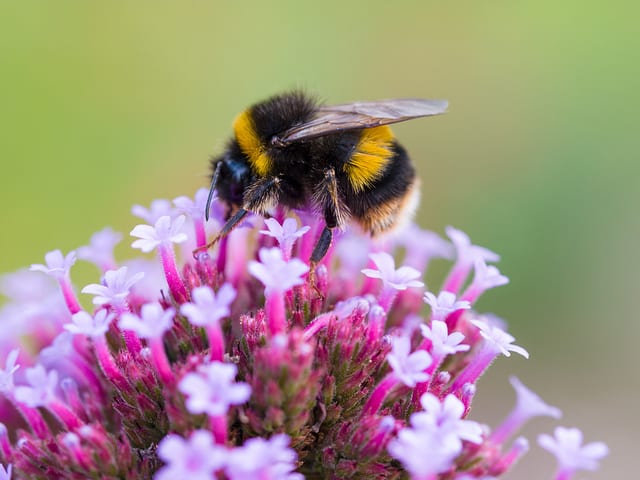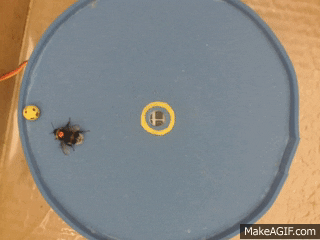Bumblebees. What comes to your mind when that word is uttered? To some, it's pure fear of its vicious sting. To others, it's the image of their toddler dressed up for Halloween. But to researchers who study bees, it's awe at the ability of such a small creature to have immense intellectual potential. Bee communities have been shown to behave and make decisions like the human brain as a whole, making their individual intelligence even more intriguing to explore in the hopes that they will give us insight into our own human brains.

You may know that bumblebees have an incredibly important place in the animal kingdom as pollinators, honey-producers and busy worker insects that live in tight-knit communities. You may also know that they were added to The Endangered Species List of the United States in 2017 due to environmental stress and pesticide use in bee habitats. But what you might not know is that this seemingly simple insect is capable of learning to play soccer!
Bee brains are a miniscule 0.5 millimeters and only contain about one million neurons, compared to one hundred billion in a human brain. However, even with 100,000 times fewer neurons than a human, bees are able to distinguish landscapes to effectively target certain flower species, shapes and sizes for nectar and can also determine which nectars are contaminated with fungus or pesticides. Not only that, they can also recognize human faces!
So it's not surprising that they are intuitively able to elect the next Queen Bee when it is just in its larval development stage. The hive collectively ensures healthy development of the selected newborn into the Queen Bee by feeding her what is known as royal jelly, a nutrient source fortified with proteins, vitamins and fats that triggers rapid growth changes in the “princess†larvae's body. In this way, bees exhibit the ability to make decisions as a cohesive hive, thereby exhibiting what is known as community intelligence.
Bees exhibit the ability to make decisions as a cohesive hive, thereby exhibiting community intelligence.
This remarkable capability is individually reflected in the ability of each bee to learn and adapt to reward-based encouragement. Around the time bees were declared endangered, a group of researchers at Queen Mary University of London published a study in Science magazine detailing the ability of bees to play soccer to receive sugar water as a reward. Previous studies have also shown that bees can be taught to pull a string, and then teach a fellow bee by demonstration to do the same. In this new study, the researchers wanted to investigate whether a bee could learn a task with an object it had never seen before: a ball.

Not only were bees taught to move the ball into a target to receive a sweet reward of sugared water, but they also learned that pulling the ball into the target was much easier than pushing it, showcasing their ability to independently innovate and refine a new task without any external motivation. However, this study revealed something even more incredible – the bees could also demonstrate the innovative method of pulling the ball into a target to other bees, thus increasing the speed at which subsequent learners picked up the skill.
The hive’s community intelligence is based on individual bees’ ability to both learn and teach.
The hive’s community intelligence is based on individual bees' ability to both learn and teach. Take scouts for example – they are assigned by the Queen Bee using pheromones (communicative chemical signals) and tasked with looking for more sources of nectar or finding a new home for the colony. Scouts actually have a slightly different chemical makeup that helps them be more adaptive and curious! When they find useful information pertaining to food or moving their colony, scouts can then successfully transfer this knowledge by doing a waggle dance for rest of bees at the hive.
It is evident that bees have figured out a way to adapt to changing environments by communicating effectively to sustain their communities, but this is not entirely uncommon in the insect community. Ants, for example, have been around since the dinosaur ages and have also found effective ways to forage for food and process information, much like Google! It's remarkable that insects with seemingly miniscule brains have such immense capability for learning, and community living and adds to the fact that bigger brains are not necessarily required for intelligence. Bees are the perfect example, but maybe ants, with even bigger communities, could give bees a run for their honey!
About the Author
 |
Sudeepti Kuppa is a Ph.D. candidate in the College of Pharmacy and studies how to develop miRNAs into early detection biomarkers for clinically challenging gynecological cancers such as ovarian or metastatic breast cancer. She also got her undergraduate degree at UGA, so she's a Double-Dawg and hasn't regretted staying in Athens for a moment! When she's not in the lab discovering cool new things about cancer, Sudeepti likes to meditate, go to the gym and make sure she gets a healthy dose of TV and spends time with her pet rabbit Fessy (who's basically a dog)! To hear more from Sudeepti you can connect with her on over on Twitter . More from Sudeepti Kuppa. |
About the Author
- athenssciencecafehttps://athensscienceobserver.com/author/athenssciencecafe/April 17, 2020
- athenssciencecafehttps://athensscienceobserver.com/author/athenssciencecafe/April 12, 2020
- athenssciencecafehttps://athensscienceobserver.com/author/athenssciencecafe/April 3, 2020
- athenssciencecafehttps://athensscienceobserver.com/author/athenssciencecafe/March 30, 2020







